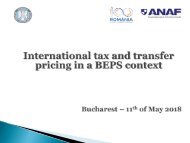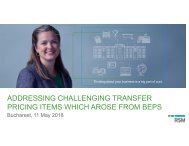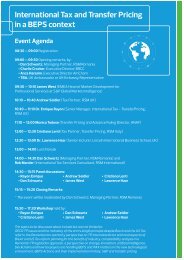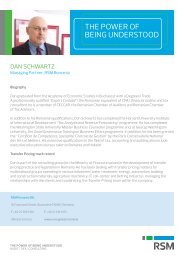2. Int'l Tax Update Significant Developments in the Global Tax System - Andrew Seidler
You also want an ePaper? Increase the reach of your titles
YUMPU automatically turns print PDFs into web optimized ePapers that Google loves.
Help<strong>in</strong>g with tax challenges wherever you are <strong>in</strong> <strong>the</strong> world<br />
INTERNATIONAL TAX UPDATE:<br />
SIGNIFICANT DEVELOPMENTS IN THE GLOBAL TAX SYSTEM<br />
Bucharest, 11 April 2018
Presenter<br />
<strong>Andrew</strong> <strong>Seidler</strong><br />
Partner, RSM UK<br />
andrew.seidler@rsmuk.com<br />
+44 20 3201 8615<br />
• International <strong>Tax</strong> Partner, RSM London<br />
• 20 years <strong>in</strong>ternational tax experience across range of taxes<br />
• Chair of RSM International European <strong>Tax</strong> Centre of Excellence<br />
• Author of Tolley’s International <strong>Tax</strong> Plann<strong>in</strong>g 2017-18 and 2018-19 (forthcom<strong>in</strong>g).<br />
2
Overview<br />
BEPS<br />
<strong>Global</strong> <strong>Tax</strong><br />
Reform<br />
US <strong>Tax</strong><br />
Reform<br />
BREXIT<br />
3
Corporate Changes
Corporate changes<br />
<strong>Tax</strong> change Post reform law Considerations<br />
Reduced Corporate <strong>Tax</strong><br />
Rate & Move to Territorial<br />
Type <strong>System</strong><br />
• Reduced 21 percent flat corporate<br />
federal <strong>in</strong>come tax rate from 35<br />
percent, generally effective Jan. 1,<br />
2018<br />
• Companies need to consider whe<strong>the</strong>r<br />
flow-through or corporate structure is<br />
most efficient<br />
• Investor make up?<br />
Net Operat<strong>in</strong>g Loss (NOL)<br />
rules<br />
• Limits NOL deduction to 80 percent<br />
of taxable <strong>in</strong>come for NOLs aris<strong>in</strong>g <strong>in</strong><br />
years beg<strong>in</strong>n<strong>in</strong>g after Dec. 31, 2017<br />
• Elim<strong>in</strong>ates NOL carrybacks for NOLs<br />
aris<strong>in</strong>g <strong>in</strong> years end<strong>in</strong>g after Dec. 31,<br />
2017<br />
• NOLs generally carried forward<br />
<strong>in</strong>def<strong>in</strong>itely if <strong>the</strong>y arise <strong>in</strong> years<br />
end<strong>in</strong>g after Dec. 31, 2017<br />
• Fiscal year taxpayers with years<br />
end<strong>in</strong>g after Dec. 31, 2017 cannot<br />
carryback losses<br />
• Limited impact on state NOLs as<br />
many states have <strong>the</strong>ir own NOL<br />
deduction provisions<br />
5
International tax provisions: Repatriation and DRD<br />
<strong>Tax</strong> Change Post Reform Law Considerations<br />
One-time deemed<br />
repatriation tax on foreign<br />
deferred earn<strong>in</strong>gs (effective<br />
for tax years beg<strong>in</strong>n<strong>in</strong>g<br />
before January 1, 2018)<br />
• Foreign deferred earn<strong>in</strong>gs are taxed<br />
at 15.5 or 8 percent based on<br />
balance sheet attributes (cash &<br />
cash equivalents vs. non-cash<br />
assets, respectively).<br />
• Election to defer payment over 8<br />
years<br />
• Determ<strong>in</strong>e applicability at portfolio and<br />
owner level<br />
• <strong>Significant</strong> diligence item as well as<br />
cash flow concern<br />
• Need to understand E&P on all<br />
impacted companies<br />
• Many states will treat <strong>the</strong> repatriation<br />
as Subpart F <strong>in</strong>come subject to full or<br />
partial dividend received deduction<br />
Dividend Received<br />
Deduction/ Participation<br />
Exemption (effective for<br />
distributions made after<br />
Dec. 31, 2017)<br />
• Certa<strong>in</strong> foreign dividends non-taxable<br />
<strong>in</strong> <strong>the</strong> US<br />
• Certa<strong>in</strong> ga<strong>in</strong>s on sale of foreign<br />
subsidiaries will not be subject to<br />
U.S. federal <strong>in</strong>come tax<br />
• Applicable to C-Corporations with<br />
foreign corporation(s)<br />
• Corporate structure may be benefit<br />
due to participation exemptions<br />
• How significant are foreign earn<strong>in</strong>gs?<br />
6
Corporate changes<br />
<strong>Tax</strong> change Post reform law Considerations<br />
Immediate Expens<strong>in</strong>g –<br />
Bonus Depreciation<br />
• 100 percent bonus depreciation<br />
through 2022, <strong>the</strong>n phased out<br />
through 2026<br />
• Applies to new and used property<br />
acquired and retroactive to assets<br />
placed <strong>in</strong> service after Sept. 27,<br />
2017<br />
• Adds more importance to purchase<br />
price allocation agreements<br />
• Asset deals are even more attractive<br />
• States may not conform<br />
• Immediate expens<strong>in</strong>g benefit is<br />
reduced to <strong>the</strong> extent it generates an<br />
NOL<br />
Corporate Alternative<br />
M<strong>in</strong>imum <strong>Tax</strong> (AMT) & AMT<br />
Credit<br />
• Repeals corporate AMT for tax years<br />
beg<strong>in</strong>n<strong>in</strong>g after Dec. 31, 2017<br />
• Credits can be refundable<br />
• Refundable credit is an unexpected<br />
benefit<br />
7
UK Plann<strong>in</strong>g Considerations: Dividend Exemption<br />
To qualify for dividend exemption <strong>the</strong> US<br />
must be a C Corp: many family companies<br />
(even sizeable ones) and f<strong>in</strong>ancial services<br />
entities are transparent <strong>in</strong> <strong>the</strong> US, too.<br />
The effect of subpart F or check<strong>in</strong>g <strong>the</strong> box<br />
for disregard is current year US taxation<br />
(with foreign tax credit) as opposed to an<br />
exempt dividend.<br />
Dividend exemption has an impact on<br />
deferral plann<strong>in</strong>g.<br />
Entity<br />
classification<br />
US<br />
UK<br />
Entity<br />
classification<br />
Non-US Affiliate<br />
EU<br />
Customer
UK Plann<strong>in</strong>g Considerations: NOL Limitation<br />
In <strong>the</strong> UK, <strong>the</strong> strategy for foreign profits often took<br />
<strong>in</strong>to account <strong>the</strong> current and brought forward NOL<br />
position <strong>in</strong> <strong>the</strong> US:<br />
• In <strong>the</strong> past <strong>the</strong>re was no credit for foreign tax if<br />
NOLs – <strong>the</strong> strategy was to defer tax on profits by<br />
avoid<strong>in</strong>g Subpart F and regard<strong>in</strong>g <strong>the</strong> UK<br />
subsidiary – to pay a dividend at a later date;<br />
• This is no longer relevant if all foreign dividends<br />
are exempt;<br />
• Absolute rate of foreign tax becomes more<br />
important though, as it is not safe to assume <strong>the</strong><br />
effective tax will be higher of US and overseas<br />
tax rates (with <strong>the</strong> US usually be<strong>in</strong>g higher);<br />
• Plann<strong>in</strong>g to use foreign tax to frank <strong>the</strong> tax on <strong>the</strong><br />
<strong>the</strong> 20% profits not covered by NOLs;<br />
• NOLs no longer fully cover disposals for example<br />
of exported IP.<br />
US<br />
UK<br />
UK<br />
EU<br />
Customer
UK Plann<strong>in</strong>g Considerations: Deemed Repatriation<br />
• This is a tax charge as if <strong>the</strong> funds<br />
had been repatriated to <strong>the</strong> US – <strong>the</strong><br />
cash does not have to be repatriated<br />
(although <strong>the</strong> tax will need fund<strong>in</strong>g,<br />
but <strong>the</strong> tax can be spread);<br />
• Is <strong>the</strong> cash accessible? Has it been<br />
tied up <strong>in</strong> acquisitions and f<strong>in</strong>anc<strong>in</strong>g?<br />
IP Co<br />
US<br />
Ireland<br />
In some<br />
groups this<br />
will be UK<br />
• If <strong>the</strong> UK is an <strong>in</strong>termediate parent<br />
company is any structur<strong>in</strong>g required<br />
whilst <strong>the</strong> UK has access to EU<br />
directives to ensure WHT free access<br />
to <strong>the</strong> cash?<br />
F<strong>in</strong> Co<br />
UK<br />
EU EUEU<br />
EU<br />
Customer
Withhold<strong>in</strong>g <strong>Tax</strong>es After Brexit<br />
• With <strong>the</strong> UK outside <strong>the</strong> EU <strong>the</strong> Parent<br />
Subsidiary Directive will no longer elim<strong>in</strong>ate<br />
dividend withhold<strong>in</strong>g taxes on payments to<br />
<strong>the</strong> UK: treaty rates will apply and <strong>the</strong>se<br />
are commonly 5%.<br />
• Where dividends are exempt from tax – <strong>in</strong><br />
<strong>the</strong> UK and now <strong>the</strong> US – withhold<strong>in</strong>g taxes<br />
represent additional tax.<br />
• Ne<strong>the</strong>rlands has just changed its law to<br />
exempt dividends from withhold<strong>in</strong>gs.<br />
US<br />
UK<br />
Dividend WHT UK US<br />
Ireland 15/5% 15/5%<br />
Germany 15/5% 15/5/0%<br />
Ireland<br />
Ne<strong>the</strong>rlands<br />
Germany<br />
Luxembourg 15/5% 15/5/0%<br />
Belgium 10/0% 15/5/0%
Withhold<strong>in</strong>g <strong>Tax</strong>es After Brexit<br />
• Hold<strong>in</strong>g EU based activities <strong>in</strong> branches<br />
or partnerships.<br />
UK<br />
• Germany:<br />
• Conversion of a company to a<br />
partnership does not trigger taxes<br />
domestically <strong>in</strong> Germany;<br />
• Partners pay tax <strong>in</strong> Germany at rates<br />
equivalent to German corporate rates;<br />
• Dividends between German resident<br />
companies should be exempt from tax;<br />
• Under <strong>the</strong> Organschaft (fiscal unity)<br />
<strong>the</strong> German group parent pays tax on<br />
behalf of <strong>the</strong> group members as if <strong>the</strong>y<br />
were one.<br />
GmbH1<br />
KG<br />
GmbH2<br />
EU o<strong>the</strong>r
Withhold<strong>in</strong>g <strong>Tax</strong>es and <strong>the</strong> Digital Economy<br />
(UK Government Position Paper)
Withhold<strong>in</strong>g <strong>Tax</strong>es and <strong>the</strong> Digital Economy<br />
Progress of Profit Split from last resort<br />
moth to method of choice;<br />
The 3% Revenues <strong>Tax</strong> is a hybrid tax:<br />
• It will have to be expressed as tax on<br />
profits o<strong>the</strong>rwise treaties will not<br />
apply;<br />
• It is on gross <strong>in</strong>come and so behaves<br />
like a withhold<strong>in</strong>g tax;<br />
• In operation it may be more like an<br />
<strong>in</strong>direct tax.<br />
Is its purpose is to pave <strong>the</strong> way for<br />
someth<strong>in</strong>g that is better, but would have<br />
o<strong>the</strong>rwise been unacceptable? CCCTB.<br />
Profit Split<br />
Digital<br />
Economy<br />
F<strong>in</strong>al<br />
Model<br />
CCCTB<br />
3%<br />
Revenues<br />
<strong>Tax</strong><br />
Digital<br />
Economy<br />
Interim<br />
Measure
Common Consolidated Corporate <strong>Tax</strong> Base<br />
On 15 March 2018 <strong>the</strong> European Parliament approved proposals for directives for <strong>the</strong> Common<br />
Corporate <strong>Tax</strong> Base and <strong>the</strong> Common Consolidated Corporate <strong>Tax</strong> Base.<br />
The directives will <strong>in</strong>itially be b<strong>in</strong>d<strong>in</strong>g on groups with revenues exceed<strong>in</strong>g EUR 750m but this<br />
threshold will be lowered reach<strong>in</strong>g zero after seven years.<br />
The <strong>in</strong>tended implementation date is 1 January 2020.<br />
The Common Consolidated Corporate <strong>Tax</strong> Base provides <strong>the</strong> method of consolidation and <strong>the</strong><br />
formula for allocat<strong>in</strong>g <strong>the</strong> tax base of a multi-national company between Member States. The<br />
allocation formula is based on headcount, sales, data collection and assets, each hav<strong>in</strong>g equal<br />
weight.<br />
Headcount<br />
Sales<br />
Data<br />
Collection<br />
Assets
Common Corporate <strong>Tax</strong> Base<br />
• A def<strong>in</strong>ition of digital permanent establishment:<br />
• Revenues exceed<strong>in</strong>g EUR 5m pa derived remotely from users <strong>in</strong> a members state,<br />
• where at least 1,000 registered <strong>in</strong>dividual users per month visited <strong>the</strong> digital platform or<br />
• at least 1,000 digital contracts have been concluded per month with customers or users<br />
<strong>in</strong> a member state<br />
• or <strong>the</strong> volume of digital content collected by <strong>the</strong> taxpayer <strong>in</strong> <strong>the</strong> year exceed10% of <strong>the</strong><br />
group’s overall stored content;<br />
• Amendments to R&D tax <strong>in</strong>centives to limit <strong>the</strong> credit to 10% of <strong>the</strong> R&D staff costs, with a<br />
maximum threshold of EUR 20m for such costs;<br />
• Limits <strong>the</strong> deductibility of f<strong>in</strong>ance costs to 10% of EBITDA or EUR1m if higher;<br />
• Limits <strong>the</strong> carry forward of losses to five years;<br />
• Disallowance of expenses paid to beneficiaries located <strong>in</strong> a jurisdiction considered to be a tax<br />
haven accord<strong>in</strong>g to <strong>the</strong> EU list of non-cooperative jurisdictions for tax purposes;<br />
• Amendments to <strong>the</strong> classification of CFCs;<br />
• Amendments to double tax treaties so that <strong>the</strong> parties agree to ensure that tax is paid where<br />
economic activities take place and add anti avoidance/anti tax-evasion clauses.<br />
• Provides for an EU wide tax identification number.
Digital Economy Interim Measure<br />
Example:<br />
For every £100 of revenue £3 of<br />
tax is due.<br />
The profits required to generate<br />
£3 of tax under traditional<br />
methods is different <strong>in</strong> each<br />
country –shown <strong>in</strong> <strong>the</strong> graph.<br />
The green l<strong>in</strong>e represents<br />
potential double tax relief<br />
limitation <strong>in</strong> relation to say <strong>the</strong> US.<br />
30<br />
25<br />
20<br />
15<br />
10<br />
5<br />
0
Digital Economy Interim Measure<br />
Effect of <strong>in</strong>terim measure:<br />
• Some sectors <strong>the</strong> 3% revenues based tax would <strong>in</strong>crease <strong>the</strong> tax take<br />
• Tak<strong>in</strong>g out centralised costs, most tech sectors would experience and effective tax rise<br />
Sector<br />
NP%<br />
2012<br />
NP%<br />
2018<br />
Information Technology 16.7 17.5<br />
Communications/Telecom 6.2 11.5<br />
Pharma, Life Sciences,<br />
Biotech<br />
19.5 26.9<br />
Media, Broadcast 10.1 1<strong>2.</strong>2<br />
<strong>Tax</strong> at<br />
20%<br />
3.5<br />
<strong>2.</strong>3<br />
5.4<br />
<strong>2.</strong>5<br />
Data from S&P 2012 and CSI Market.com 2018
BEPS Measures:<br />
Anti-hybrid rules<br />
Interest Limitation
US Outbound Acquisition<br />
Typical simple structure <strong>in</strong> <strong>the</strong> past for<br />
an outbound acquisition from <strong>the</strong> US:<br />
applied <strong>in</strong> o<strong>the</strong>r jurisdictions too:<br />
• Dutch BV/CV<br />
• Double Lux co for debt<br />
Acquisition<br />
US<br />
UK<br />
Holdco<br />
Non-US Affiliate<br />
Interest<br />
Interest<br />
group relief<br />
UK
Anti-hybrid provisions
US Hybrid Rules<br />
A “hybrid entity” is any entity that is:<br />
• Fiscally transparent for US tax purposes but<br />
not transparent under foreign law, or<br />
• Fiscally transparent for foreign law<br />
purposes, but not transparent for US tax<br />
purposes.<br />
A “hybrid transaction” is any transaction, series<br />
of transactions, agreement, or <strong>in</strong>strument<br />
• treated as <strong>in</strong>terest or royalties for US federal<br />
tax purposes<br />
• but not treated as <strong>in</strong>terest or royalties by <strong>the</strong><br />
country <strong>in</strong> which <strong>the</strong> related party is resident.<br />
US hybrid<br />
entity<br />
Acquisition<br />
US<br />
UK<br />
Holdco<br />
Non-US Affiliate<br />
UK<br />
Not a US<br />
hybrid<br />
transaction<br />
Interest<br />
Interest<br />
group relief
US Hybrid Counteraction<br />
The Act denies a deduction for any disqualified<br />
related party amount paid or accrued pursuant<br />
to a hybrid transaction or by or to a hybrid<br />
entity.<br />
US hybrid<br />
entity<br />
US<br />
Disqualified<br />
related party<br />
amount<br />
Interest<br />
A “disqualified related party amount” is any<br />
<strong>in</strong>terest or royalty paid to a related party where<br />
<strong>the</strong> related party<br />
• does not <strong>in</strong>clude <strong>the</strong> payment <strong>in</strong> its <strong>in</strong>come<br />
<strong>in</strong> <strong>the</strong> country <strong>in</strong> which it is a resident or<br />
• is allowed a deduction with respect to <strong>the</strong><br />
amount <strong>in</strong> <strong>the</strong> country <strong>in</strong> which it is a<br />
resident.<br />
Acquisition<br />
UK<br />
Holdco<br />
Non-US Affiliate<br />
UK<br />
Interest<br />
group relief<br />
Treasury Regulations expected.
UK approach<br />
Type Mismatch <strong>in</strong>volv<strong>in</strong>g Primary Response Defensive Rule Scope<br />
D/NI Ch 3: F<strong>in</strong>ancial Instruments Deny payer deduction<br />
Related parties and structured<br />
Include as ord<strong>in</strong>ary <strong>in</strong>come<br />
arrangements<br />
D/NI Ch 4: Hybrid Transfers Deny payer deduction<br />
Related parties and structured<br />
Include as ord<strong>in</strong>ary <strong>in</strong>come<br />
arrangements<br />
D/NI Ch 5: Hybrid Payer Deny payer deduction<br />
Control group and structured<br />
Include as ord<strong>in</strong>ary <strong>in</strong>come<br />
arrangements<br />
D/NI<br />
Ch 6 Transfers by<br />
Permanent Establishments<br />
Deny deduction to UK PE No limitation on response<br />
D/NI Ch 7: Hybrid Payee Deny payer deduction<br />
Include as ord<strong>in</strong>ary <strong>in</strong>come Control group and structured<br />
<strong>in</strong> <strong>in</strong>vestor, <strong>the</strong>n LLP arrangements<br />
D/NI Ch 8: Mult<strong>in</strong>ational Payee Deny payer deduction<br />
Control group and structured<br />
arrangements<br />
DD Ch 9: Hybrid Entity Deny <strong>in</strong>vestor deduction Deny payer deduction<br />
Related parties and structured<br />
arrangements<br />
Dual resident company deny<br />
deduction<br />
DD<br />
D/NI<br />
Ch 10: Dual Territory<br />
Mult<strong>in</strong>ational company: deny<br />
parent jurisdiction deduction<br />
Ch 11: Imported Mismatches Deny payer deduction<br />
Tolley’s International <strong>Tax</strong> Plann<strong>in</strong>g 2017/18<br />
Mult<strong>in</strong>ational company:<br />
deny deduction to UK PE<br />
No limitation on response<br />
Control group and structured<br />
arrangements
UK approach compared to US<br />
Type Mismatch <strong>in</strong>volv<strong>in</strong>g<br />
Primary Response<br />
D/NI<br />
Ch 3: F<strong>in</strong>ancial<br />
Instruments<br />
Deny payer deduction<br />
D/NI Ch 4: Hybrid Transfers Deny payer deduction<br />
D/NI Ch 5: Hybrid Payer Deny payer deduction<br />
D/NI<br />
Ch 6 Transfers by<br />
Permanent<br />
Deny deduction to UK PE<br />
Establishments<br />
D/NI Ch 7: Hybrid Payee Deny payer deduction<br />
D/NI<br />
Ch 8: Mult<strong>in</strong>ational<br />
Payee<br />
Deny payer deduction<br />
DD Ch 9: Hybrid Entity Deny <strong>in</strong>vestor deduction<br />
Dual resident company<br />
deny deduction<br />
DD<br />
D/NI<br />
Ch 10: Dual Territory<br />
Ch 11: Imported<br />
Mismatches<br />
Mult<strong>in</strong>ational company:<br />
deny parent jurisdiction<br />
deduction<br />
Deny payer deduction<br />
US hybrid<br />
entity<br />
Acquisition<br />
US<br />
UK<br />
Holdco<br />
Non-US Affiliate<br />
UK<br />
Not a US<br />
hybrid<br />
transaction?<br />
Interest<br />
Interest<br />
group relief<br />
Who has to disallow first?
Hybrids and s<strong>in</strong>gle member disregards<br />
Type Mismatch <strong>in</strong>volv<strong>in</strong>g<br />
Primary Response<br />
D/NI<br />
Ch 3: F<strong>in</strong>ancial<br />
Instruments<br />
Deny payer deduction<br />
D/NI Ch 4: Hybrid Transfers Deny payer deduction<br />
D/NI Ch 5: Hybrid Payer Deny payer deduction<br />
D/NI<br />
Ch 6 Transfers by<br />
Permanent<br />
Deny deduction to UK PE<br />
Establishments<br />
D/NI Ch 7: Hybrid Payee Deny payer deduction<br />
D/NI<br />
Ch 8: Mult<strong>in</strong>ational<br />
Payee<br />
Deny payer deduction<br />
DD Ch 9: Hybrid Entity Deny <strong>in</strong>vestor deduction<br />
Dual resident company<br />
deny deduction<br />
DD<br />
D/NI<br />
Ch 10: Dual Territory<br />
Ch 11: Imported<br />
Mismatches<br />
Mult<strong>in</strong>ational company:<br />
deny parent jurisdiction<br />
deduction<br />
Deny payer deduction<br />
Not a US<br />
disqualified<br />
related party<br />
amount<br />
by nature<br />
US<br />
Cost Plus<br />
US hybrid<br />
entity<br />
US<br />
UK<br />
I<br />
Not a US<br />
hybrid entity<br />
FA 2018 fix<br />
for dual<br />
<strong>in</strong>clusion<br />
<strong>in</strong>come<br />
EU<br />
Customer
Interest Limitation
Interest deduction limitations<br />
<strong>Tax</strong> Change<br />
New Interest<br />
Deduction<br />
Limitation<br />
Post Reform Law<br />
• Limits <strong>the</strong> net <strong>in</strong>terest expense<br />
deduction to 30 percent of adjusted<br />
taxable <strong>in</strong>come (ATI)<br />
• For 2018 through 2021, ATI will<br />
approximate earn<strong>in</strong>gs before<br />
<strong>in</strong>terest, taxes, depreciation and<br />
amortization (EBITDA)<br />
• After 2021, ATI will approximate<br />
earn<strong>in</strong>gs before <strong>in</strong>terest and taxes<br />
(EBIT)<br />
• Disallowed <strong>in</strong>terest generally may<br />
be carried forward <strong>in</strong>def<strong>in</strong>itely<br />
• Limitation does not apply to<br />
bus<strong>in</strong>esses with an average<br />
gross receipts of ≤$25 million<br />
USD and certa<strong>in</strong> agricultural,<br />
farm<strong>in</strong>g and real estate<br />
bus<strong>in</strong>esses<br />
• “Net <strong>in</strong>terest expense” so back<br />
to back loans rema<strong>in</strong> viable for<br />
<strong>in</strong>tercompany f<strong>in</strong>anc<strong>in</strong>g<br />
activities<br />
• Real property trade or<br />
bus<strong>in</strong>esses that use ADS and<br />
farm<strong>in</strong>g bus<strong>in</strong>esses may elect<br />
not to be subject to <strong>the</strong> bus<strong>in</strong>ess<br />
<strong>in</strong>terest deduction limitation<br />
28
Interest deduction – comparison with UK<br />
Small company exemption:<br />
• US def<strong>in</strong>ed de m<strong>in</strong>imis by type companies<br />
and nature of trade;<br />
• UK def<strong>in</strong>es de m<strong>in</strong>imis as amount of<br />
<strong>in</strong>terest £2m.<br />
Allowable amount:<br />
• US def<strong>in</strong>es it by fixed ration of ATI;<br />
• UK def<strong>in</strong>es it by fixed ration of tax EBITDA<br />
or group debt ratio is larger.<br />
IP Co<br />
US<br />
Ireland<br />
Non-US Affiliate<br />
External<br />
Plann<strong>in</strong>g to spread <strong>the</strong> deduction <strong>in</strong> <strong>the</strong><br />
group – excessive disallowance if<br />
concentrated too narrowly - limitation on net<br />
expense.<br />
F<strong>in</strong> Co<br />
UK<br />
EU EUEU<br />
UK Th<strong>in</strong> Capitalisation as an overlay on <strong>the</strong><br />
<strong>in</strong>terest restriction gives rise to tax leakage.
GILTI<br />
FDII<br />
BEAT
<strong>Global</strong> Intangible<br />
Low <strong>Tax</strong>ed Income<br />
GILTI
International tax provisions: GILTI M<strong>in</strong>imum <strong>Tax</strong><br />
<strong>Tax</strong> change Post reform law Considerations<br />
<strong>Global</strong> Intangible<br />
Low <strong>Tax</strong>ed Income<br />
(GILTI) (effective for<br />
tax years beg<strong>in</strong>n<strong>in</strong>g<br />
after Dec. 31, 2017)<br />
• Targeted at foreign<br />
corporations that earn a<br />
high rate of return on <strong>the</strong>ir<br />
<strong>in</strong>tangible assets<br />
• Much broader than<br />
<strong>in</strong>tangible hold<strong>in</strong>g<br />
companies<br />
• All <strong>in</strong>dustries<br />
• Calculates tax on amount<br />
over net deemed tangible<br />
<strong>in</strong>come<br />
• GILTI applies to any CFC<br />
• C corporations receive a<br />
deduction aga<strong>in</strong>st GILTI<br />
equal to 50 percent<br />
• Expectation is that many CFCs will be<br />
subject to GILTI<br />
• Effectively a 10.5 percent m<strong>in</strong>imum tax<br />
CFC is owned by a domestic C Corp<br />
• Eligible for partial foreign tax credit<br />
offset<br />
• New diligence item<br />
32
GILTI Example Calculation<br />
GILTI Calculation<br />
QBAI 200<br />
Rout<strong>in</strong>e % of return – 10% 10%<br />
Net deemed tangible return 20<br />
Net CFC tested <strong>in</strong>come 120<br />
Net deemed tangible return (20)<br />
GILTI 100<br />
US <strong>Tax</strong> Calculation<br />
GILTI 100<br />
Allowed deduction (50% of GILTI) 50<br />
US <strong>Tax</strong>able Income 50<br />
<strong>Tax</strong> Rate 21%<br />
US <strong>Tax</strong> (A) 10.5<br />
Qualified bus<strong>in</strong>ess asset <strong>in</strong>vestment (“QBAI”):<br />
Equals <strong>the</strong> CFC’s average aggregate adjusted bases<br />
for specified tangible property.<br />
Rout<strong>in</strong>e return is 10% x QBAI - Net Interest Expense<br />
Interest expense less allocable <strong>in</strong>terest <strong>in</strong>come<br />
taken <strong>in</strong>to account <strong>in</strong> determ<strong>in</strong><strong>in</strong>g net tested <strong>in</strong>come.<br />
Net CFC tested <strong>in</strong>come: The excess (if any) of <strong>the</strong><br />
aggregate tested <strong>in</strong>come of each CFC less <strong>the</strong><br />
aggregate tested loss of each CFC.<br />
Example assumes no foreign taxes paid – generally<br />
80% of foreign taxes paid (subject to limitations) may<br />
be available to offset US taxes paid on GILTI
UK Plann<strong>in</strong>g Considerations: GILTI Income Sources<br />
What is <strong>the</strong> impact on R&D and Patent<br />
box type arrangements which trigger<br />
foreign tax breaks?<br />
Product and<br />
Brand<br />
US<br />
Not compliant with <strong>the</strong> Nexus<br />
requirement <strong>in</strong> BEPS – some countries<br />
may impose withhold<strong>in</strong>gs on royalties.<br />
IP Co<br />
Ireland<br />
R&D<br />
<strong>in</strong>tangibles<br />
from buy <strong>in</strong><br />
Although <strong>the</strong> GILTI tax rate is 10.5%<br />
and so comparable to <strong>the</strong> rates under<br />
some preferred IP regimes,<br />
• The tax base is foreign <strong>in</strong>come over<br />
an IRS accepted base level, and so<br />
• The foreign <strong>in</strong>come may not be<br />
repatriated to US to claim foreign<br />
tax credit.<br />
F<strong>in</strong> Co<br />
UK<br />
Customer<br />
related<br />
<strong>in</strong>tangibles<br />
EU EUEU
Foreign Derived Intangible Income<br />
FDII
Foreign Derived Intangible Income Deduction – FDII<br />
<strong>Tax</strong> change Post reform law Considerations<br />
Foreign Derived<br />
Intangible Income<br />
(FDII) (effective for<br />
tax years beg<strong>in</strong>n<strong>in</strong>g<br />
after Dec. 31,<br />
2017)<br />
• Deduction results <strong>in</strong> an<br />
effective 13.125 percent<br />
• Applicable for Domestic C<br />
corporations with gross<br />
<strong>in</strong>come generated by<br />
revenues to foreign<br />
customers for foreign use<br />
• Products & services<br />
revenue with respect to<br />
property not located<br />
with<strong>in</strong> <strong>the</strong> US<br />
• Requires base<br />
calculations of “tangible”<br />
<strong>in</strong>come and <strong>in</strong>tangible<br />
<strong>in</strong>come<br />
• Consider us<strong>in</strong>g C corporations to take<br />
advantage of FDII deductions<br />
• Need to identify and document<br />
qualification of this deduction<br />
• Sales to domestic unrelated parties before<br />
f<strong>in</strong>al overseas sale elim<strong>in</strong>ates benefit<br />
• New diligence item<br />
36
FDII Example<br />
US<br />
Corp<br />
US<br />
sales<br />
$500<br />
Revenue<br />
$1,000<br />
Revenue<br />
Non US<br />
related or<br />
unrelated<br />
U.S. Corp.<br />
P&L<br />
Sales of products for use <strong>in</strong> <strong>the</strong> U.S. 500.0<br />
Sales of products for use outside <strong>the</strong> U.S. 1,000.0<br />
Total deductiable eligible revenue 1,500.0<br />
COGS 300.0<br />
Gross profit 1,200.0<br />
Allocable deductions (<strong>in</strong>clud<strong>in</strong>g Interest) 100.0<br />
Potential FDII eligible <strong>in</strong>come 1,100.0<br />
O<strong>the</strong>r <strong>in</strong>come/(deduction) for non-FDII eligible activities -<br />
<strong>Tax</strong>able <strong>in</strong>come 1,100.0<br />
Qualified Bus<strong>in</strong>ess Asset Investments (QBAI) 500.0
FDII Example<br />
Step 1: Determ<strong>in</strong>e Deduction Eligible Income (DEI)<br />
Gross <strong>in</strong>come 1,200.0<br />
Less Subpart F <strong>in</strong>come -<br />
Less GILTI <strong>in</strong>come -<br />
Less F<strong>in</strong>ancial services <strong>in</strong>come -<br />
Less Dividend received from CFC -<br />
Less Domestic oil and gas extraction <strong>in</strong>come -<br />
Less foreign branch <strong>in</strong>come -<br />
Adjusted Gross Income 1,200.0<br />
Less Allocable deductions 100.0<br />
DEI 1,100.0 A<br />
Step 2: Reduce by Rout<strong>in</strong>e Return<br />
QBAI 500.0<br />
Apply Rout<strong>in</strong>e Return Factor 10.0%<br />
Less Interest expense <strong>in</strong>cluded <strong>in</strong> allocable deductions w/o <strong>in</strong>terest <strong>in</strong>come -<br />
Rout<strong>in</strong>e Return 50.0 B<br />
Step 3: Determ<strong>in</strong>ed Deemed Intangible Income (DII)<br />
(DEI - (10% x QBAI)) 1,050.0 C = A - B
FDII Example<br />
Step 4: Determ<strong>in</strong>e Ratio of Foreign-derived deduction eligible <strong>in</strong>come (FDDEI) to DEI<br />
Foreign revenue 1,000.0<br />
COGS 200.0<br />
Gross profit 800.0<br />
Allocable deductions 66.7<br />
FDDEI 733.3 D<br />
FDDEI / DEI ratio<br />
66.7% E = D / A<br />
Step 5: Determ<strong>in</strong>e Foreign Derived Intangible Income (FDII)<br />
Determ<strong>in</strong>e <strong>in</strong>itial FDII (DII x (FDDEI/DEI)) 700.0<br />
Less Limitation of FDII based on taxable <strong>in</strong>come -<br />
FDII 700.0<br />
Step 6: Determ<strong>in</strong>e FDII Deduction<br />
FDII Deduction factor 37.5%<br />
FDII Deduction 26<strong>2.</strong>5
FDII Example Summary<br />
<strong>Tax</strong>able <strong>in</strong>come 1,100.0<br />
FDII Deduction 26<strong>2.</strong>5<br />
Adjusted <strong>Tax</strong>able Income 837.5<br />
<strong>Tax</strong> Rate 21.0%<br />
Total <strong>Tax</strong> 175.9<br />
U.S. Corp. ETR 15.989%
UK Plann<strong>in</strong>g Considerations: FDII<br />
Purpose is to encourage groups to<br />
ei<strong>the</strong>r br<strong>in</strong>g IP back to <strong>the</strong> US or to<br />
leave it <strong>in</strong> <strong>the</strong> US.<br />
Beneficial tax rate (13.125%) applies<br />
to US sales to foreign customers.<br />
Does not apply to <strong>in</strong>come taxed on a C<br />
Corporation <strong>in</strong> <strong>the</strong> US from<br />
disregarded subsidiaries.<br />
IP Co<br />
US<br />
Ireland<br />
F<strong>in</strong> Co<br />
UK<br />
EU EUEU
Base Erosion Anti-abuse <strong>Tax</strong><br />
BEAT
BEAT – Base Erosion Anti-Abuse <strong>Tax</strong><br />
<strong>Tax</strong> change Post reform law Considerations<br />
43<br />
Base Erosion<br />
and Anti Abuse<br />
<strong>Tax</strong> (BEAT)<br />
(effective for tax<br />
years beg<strong>in</strong>n<strong>in</strong>g<br />
after Dec. 31,<br />
2017)<br />
• 10% m<strong>in</strong>imum tax on U.S. corporations (5% for<br />
2018).<br />
• Applies where 10% of ‘modified taxable<br />
<strong>in</strong>come’ (MTI) exceeds regular tax.<br />
• MTI is taxable <strong>in</strong>come without regard to base<br />
erosion tax benefit (i.e., no deduction for base<br />
erosion payments).<br />
• Base erosion payments <strong>in</strong>clude any deductible<br />
amount paid/accrued to a foreign related party.<br />
• Includes payments for depreciable property or<br />
<strong>in</strong>surance payment.<br />
• Excludes items that reduce gross receipts (like<br />
cost of goods sold).<br />
• Threshold for related party status 25 percent<br />
vote or value.<br />
BEAT applies to U.S.<br />
corporations not treated as<br />
flow-through (e.g. S corps,<br />
REITS, RICs).<br />
USD 500 million of domestic<br />
gross receipts if base erosion<br />
percentage is 3 percent or<br />
higher.<br />
Members of U.S. consolidated<br />
group are treated as s<strong>in</strong>gle<br />
corporation.
UK Plann<strong>in</strong>g Considerations: BEAT Outbound<br />
• COGS is outside <strong>the</strong> scope of BEAT:<br />
ensure all COGS items are properly<br />
identified.<br />
US<br />
• Equity contributions to fund R&D /<br />
cost shar<strong>in</strong>g arrangements with<br />
foreign affiliates.<br />
IP Co<br />
Equity<br />
Ireland<br />
Manufacturer<br />
F<strong>in</strong> Co<br />
UK<br />
EU EUEU
UK Plann<strong>in</strong>g Considerations: BEAT Inbound<br />
• Inbound parent / subsidiary loans<br />
could be replaced by parentguaranteed<br />
third-party loans and so<br />
avoid BEAT (however see Interest<br />
Limitation).<br />
Service agreements<br />
UK<br />
US<br />
External debt with<br />
parent guarantee
QUESTIONS
Brexit Monitor<br />
Visit https://www.rsmuk.com/ideas-and-<strong>in</strong>sights/brexit-monitor for news and <strong>in</strong>formation about Brexit
<strong>Tax</strong> Reform Resource Center<br />
Visit our tax reform resource center for more <strong>in</strong>formation on how legislation can affect your bus<strong>in</strong>ess<br />
and tax plann<strong>in</strong>g. www.rsmus.com/taxreform
THANK YOU
















